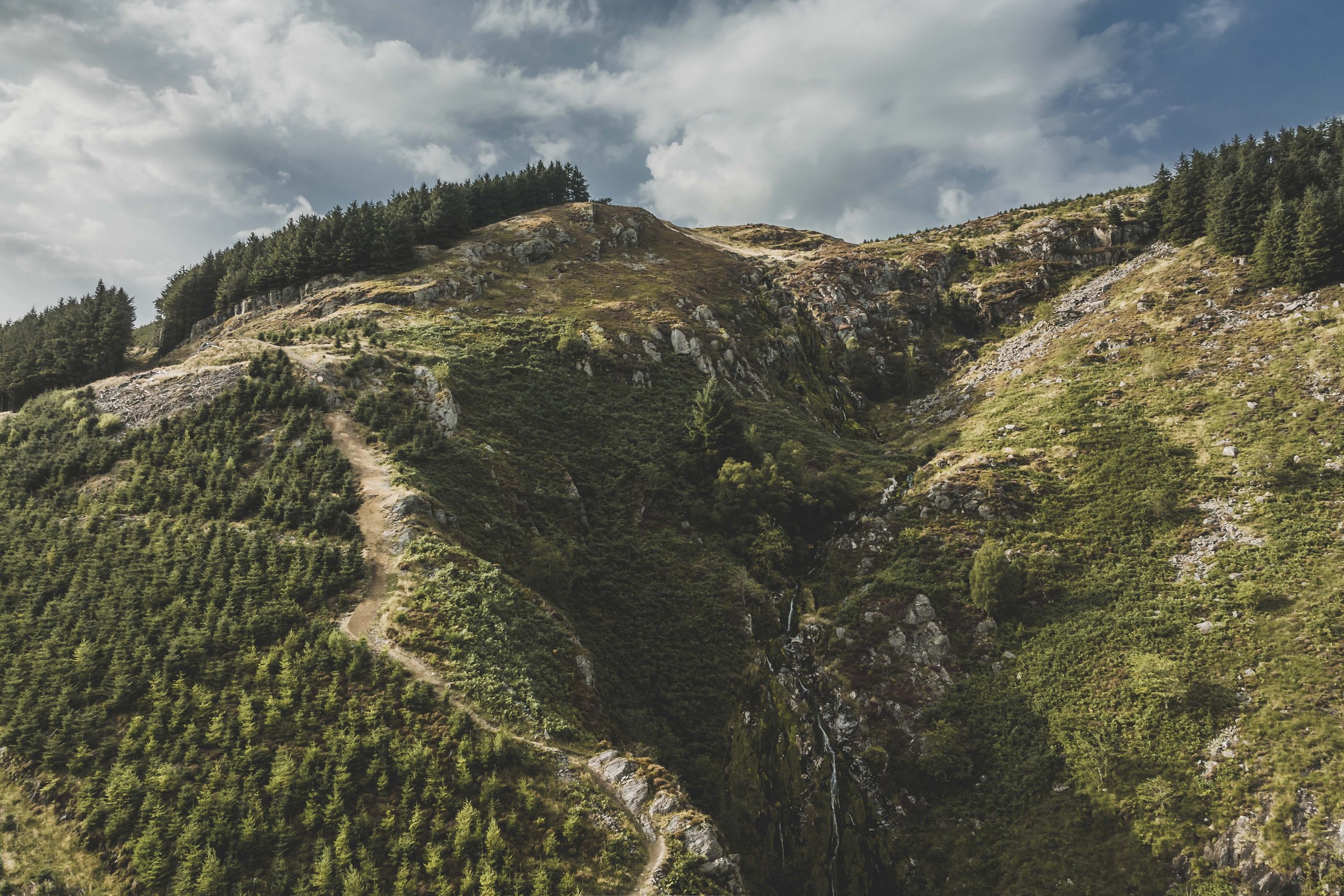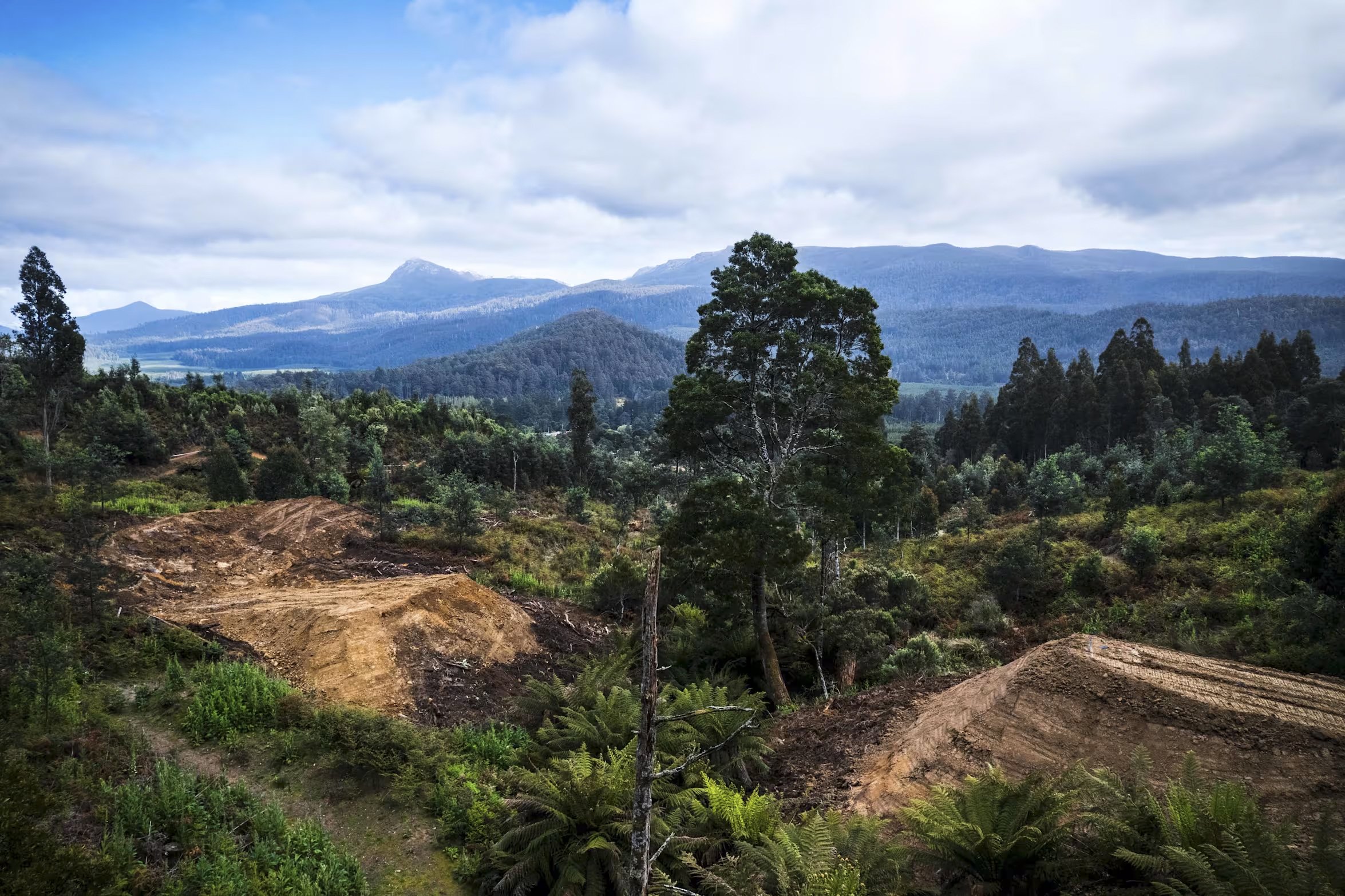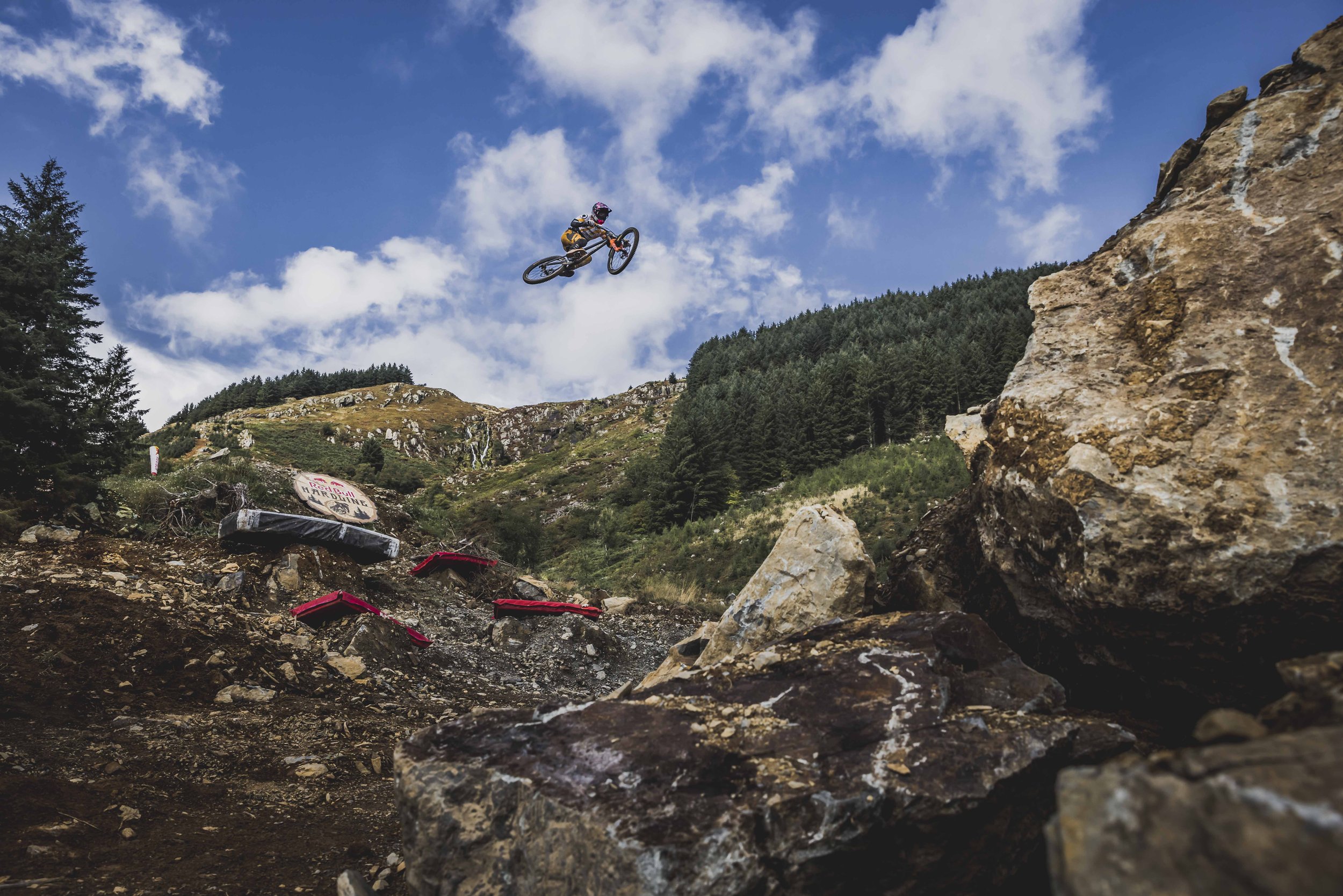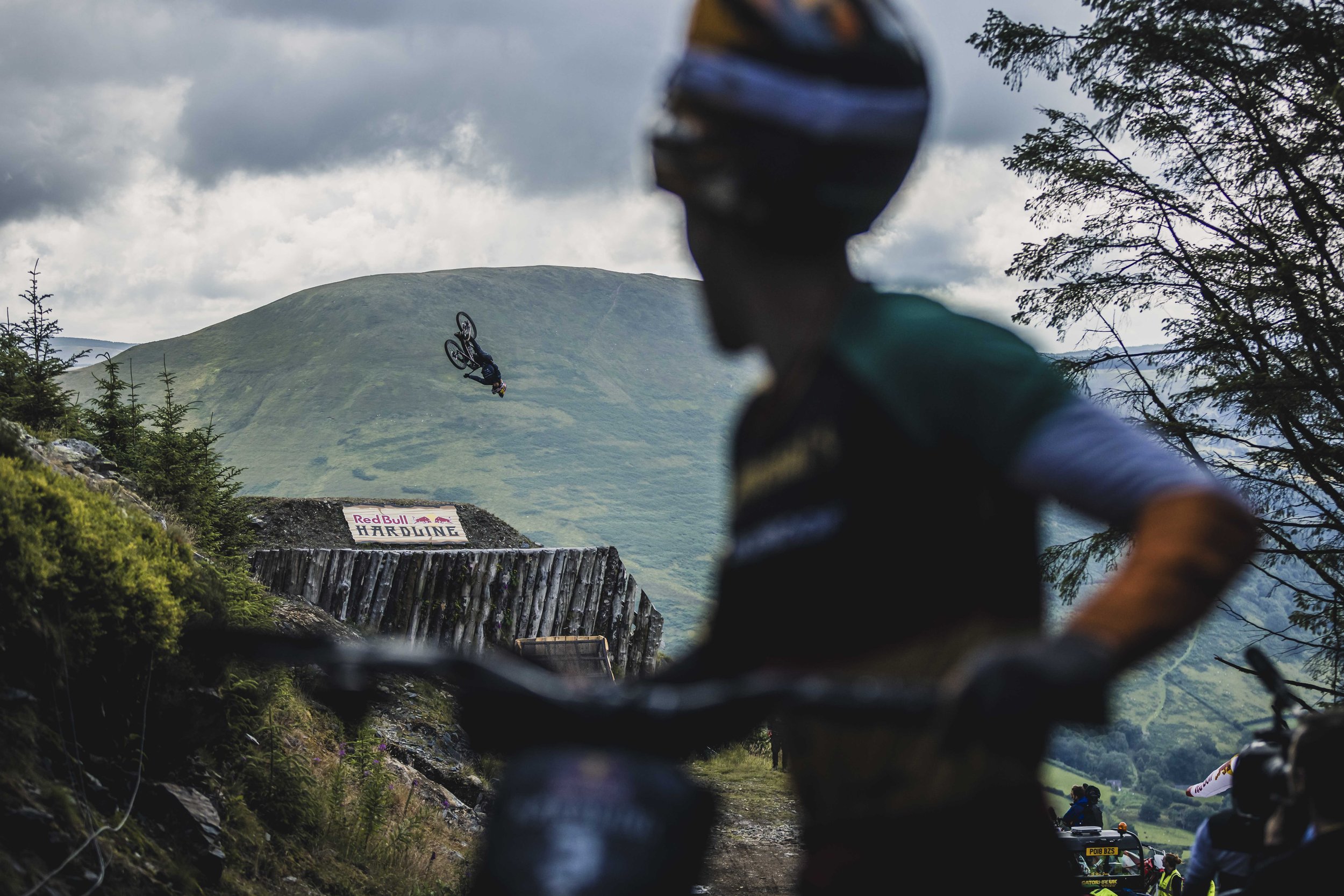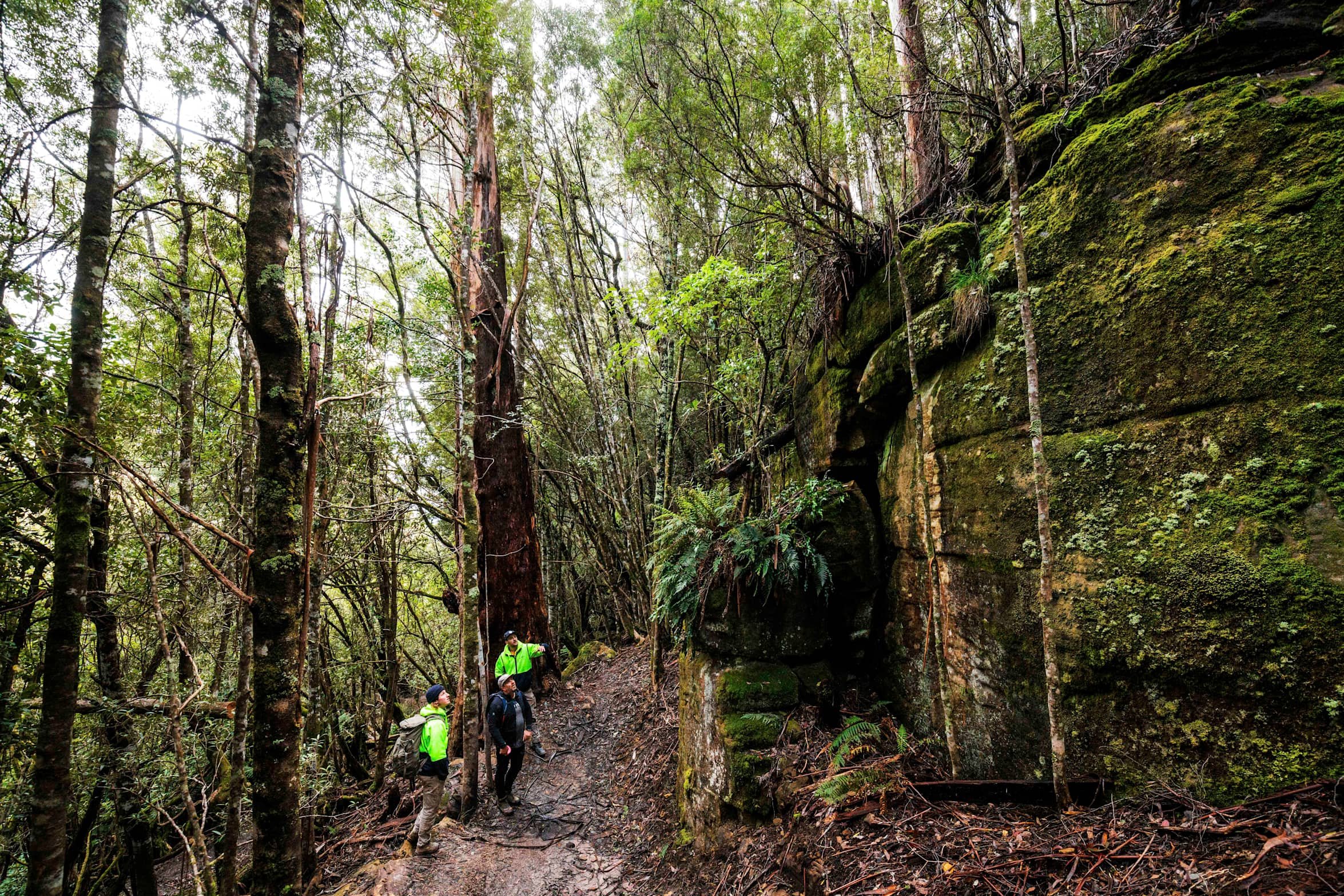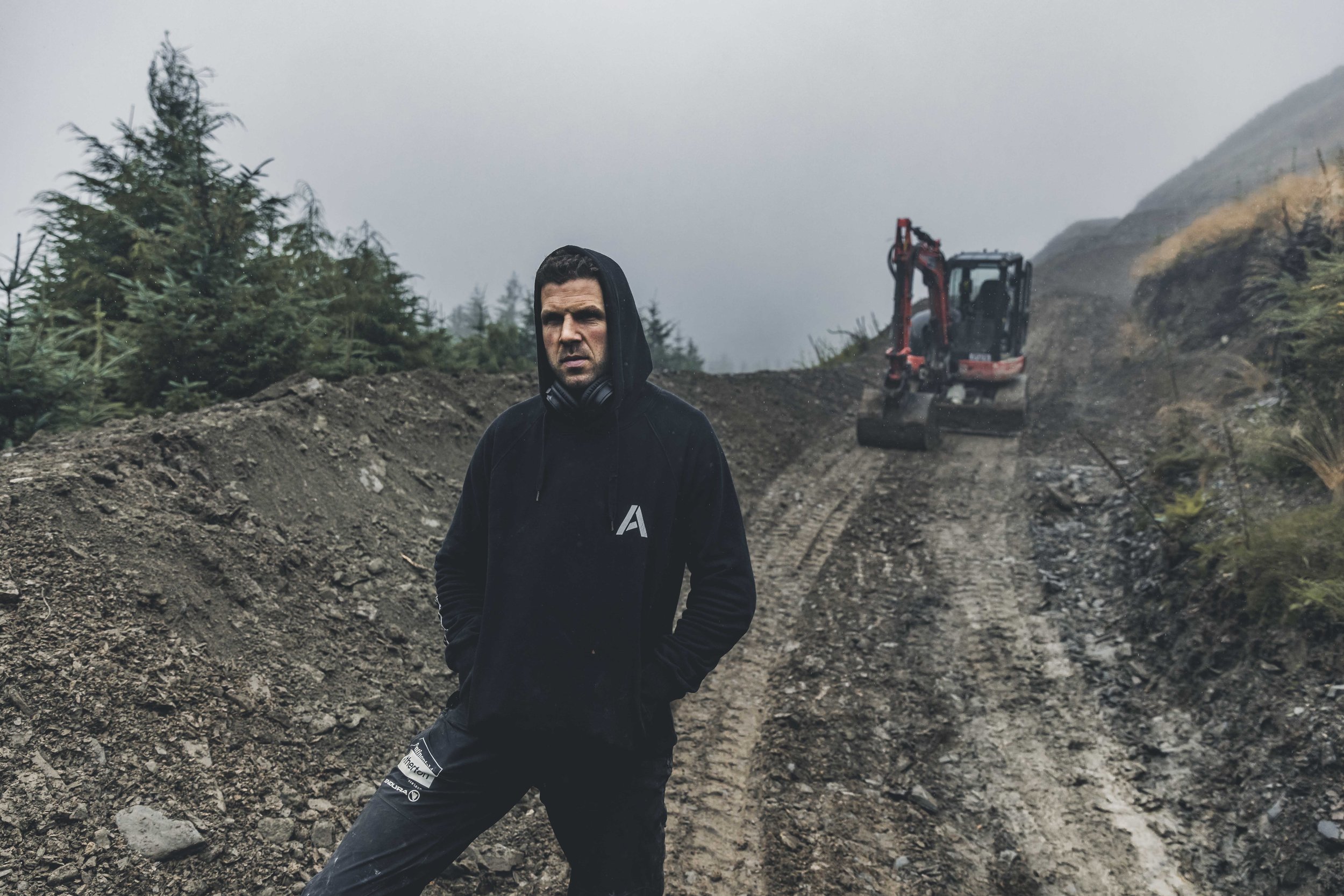Next Chapter - The Evolution of Red Bull Hardline
Chapter 1: Evolution
"What makes Hardline different from other downhill races is that the riders are against the course rather than against each other. On race day, few riders are comfortable enough to push it, and for the most part, their competition is the course, not the other racers."
- Dan Atherton
Red Bull Hardline's lifespan stretches back a decade, from its humble beginnings as a private test event in 2014 to the present day, where it's solidified itself as mountain biking's most highly anticipated downhill race
In its debut year, the Hardline course saw more features per metre than any race before, and it's only grown each year since. When you consider the driving force behind its evolution - Dan Atherton - it's no surprise that the event has grown into what it is today. We're talking about a man obsessed with progression, whether that's pushing the boundaries of the sport, bike technology, or his own personal limits.
Red Bull Hardline was no exception… Dan wanted to remind people how gnarly mountain biking could be, and in Wales, he'd found the perfect place to do it. When the idea of Hardline came about, Dan was in the process of moving over to Dyfi. He'd raced over there back in the day and was already familiar with the limitless riding potential in the area. When Red Bull first spoke to Dan about making Hardline an event, it was vital to him that Hardline was not just a spectacle but a race that would test even the most elite rider to the max.
The first year was kept under wraps as a test to see if the concept could work. Invitation only, there were no spectators, only David vs. Goliath, which in this case was nine riders against a monster of a course. The guinea pigs comprised Gee and Dan Atherton and locals Joe Smith, Alex Bond, and Gareth Brewing. Further afield brought the likes of Loic Bruni, Niko Vink, Brendan Fairclough, Sam Dale, and Danny Hart, who went on to take the win - a mixed bunch of racers and freeriders, handpicked to test a course that would require the highest level of skill from both disciplines just to survive, let alone have a chance at winning.
“From day one, the motivation for hardline was progression - progressing not only the riding and how hard the riders can push but also what’s possible in terms of course building. After ten years of hardline, it’s time for the event itself to progress, and with that, we needed new challenges and a fresh style.”
- Dan Atherton
The next step in that progression would involve a whole new location - a blank canvas with the potential to push the boundaries even further again. The Welsh Hardline course has progressed vastly over its decade-long lifespan, yet even still, riders have become more and more comfortable riding it each year as bike technology and riding have evolved.
The addition of a second location brought with it the first of many challenges; creating and maintaining a course that can keep up with Dan's vision for Hardline is no easy feat, and this knowing has locked it in as a solely Welsh endeavour until now.
“The Welsh track is right on our doorstep, so we can monitor every single decision and every single step, not only ourselves, but with Red Bull UK, who we’ve built up a solid team with over the last ten years, so to step away from that, and put on a product as impressive as hardline wales was a challenge, and there was a lot stacked against us.”
- Dan Atherton
Equally as important has been the timing. While downhill racing was all about World Cups ten years ago, nowadays, with the progression of freeracers, riders are beginning to step away from traditional mountain bike career paths, and the appetite for these more progressive style events is stronger than ever.
Though rightfully protective of Hardline's legacy, Dan knew it was time to bite the bullet and tune into some of the event's untapped potential, and with the world as their playground, so began the process of finding a new location.
Chapter 2: Tasmania
You’ve really got to see it in the flesh to get an idea of the scale and severity of a course like Hardline. We didn’t make any commitments until we’d been over there, had a good look at it, and chatted today and, the people involved about what it would take.”
- Simon French | Maydena's Managing Director
As the event moves into its next chapter, it's been vitally important that the progression aligns with the Hardline's core values. Taking on an event like Red Bull Hardline is a daunting undertaking, and there are few locations or entities with the resources and dedication required to tackle it.
Simon French and the team at Maydena Bike Park came forward last year with a bold strategy to bring Hardline to the Southern Hemisphere. With a massive hill and some wild terrain, they were confident they had what was needed to bring Hardline Tasmania to fruition.
After a trip to Hardline Wales in 2023 and a good chat with the UK team, Simon decided they had the space and resources to make it happen. Having seen the Welsh course in the flesh and hearing Dan's plans to scale things up even more for 2024, he knew they'd have to bring everything to the table to create something that could live up to expectations... but that didn't deter him.
"Seeing hardline in the flesh was pretty terrifying. A lot of people know the scale of it technically, but the Welsh course is super exposed, rugged, and rough, and most of it is out in the open, so you're riding on these big, craggy ridgelines, and it's pretty gnarly."
- Simon French | Maydena's Managing Director
After speaking to a bunch of the athletes, the general consensus was that riders love the event - it's something different, and there's a common sentiment across the top end of the downhill field that World Cups are becoming a little bit too easy, while Hardline allows them to push the absolute boundaries of their riding.
One non-negotiable made clear to Simon was that the course would need to be at a level that is almost impossible to ride - otherwise, that's just not what Hardline is about. Dan wanted to push things further - not to the point of being unsafe - but to a level where the riders were right at the edge of their capabilities.
"I was told we needed to bring a lot of technicalities back to the course and go even bigger with the features, dialing things up to the point that riders are scared to ride it again."
- Simon French | Maydena's Managing Director
Maydena, being a core, rider-focused bike park closely aligned with how the Athertons do things with Dyfi Bike Park in the UK, it was decided they would be a strong candidate for the challenge. Along with having a hill that's super well matched for Hardline, they're also one of the few places in the country able to build outrageously big things without running up against all sorts of planning and approvals hurdles.
In that sense, the planets aligned well for Maydena, but how does one even begin building a Hardline-level course?
"Knowing we were competing against the Welsh course wasn't something we undermined, and after Dan's visit to Maydena in late '23, work began with a lengthy design phase. Hearing his plans to make things bigger and more technical in 2024, a lot of time and energy went into figuring out the technical aspects of where the course would sit on the hill, how long it would be, and how much elevation would be used, along with all those tricky event logistics like venue access, camera placement for the broadcast, and figuring out how on earth the small township of Maydena, with a population of 198 as of 2021, would handle 7,000 spectators come event week."
- Simon French | Maydena's Managing Director
Being limited by the vehicles they could use on Maydena's small, dirt fire roads, shuttling a dozen or more build crew up and down the mountain each day brought its own challenges. Moving heavy machinery and equipment across an existing bike park and working around the already pre-existing trails wasn't easy, and all things considered, the Maydena crew did an incredible job at pulling things together in the small time frame they had.
The build was managed entirely by Maydena Bike Park and Simon's Dirt Art trail development company. Completed over four months, it was an ambitious task to get everything done, and the build process differed vastly from the one in Wales. The project saw around twelve trail builders and five machine operators, each with their own creative flair, spread out across different course sections to make things as efficient as possible.
Simon Palmer managed much of the carpentry across the build, including the notable container road gap, and he also worked on the Welsh Hardline course in 2023. He said the two build processes differed quite vastly.
"Things were a lot more complicated in Maydena - we were working within a tightly packed jungle with no real vehicle access, so fuel and equipment had to be carried in each day, and logistically, the Tasmania build was a lot more challenging."
- Simon Palmer | Head of Carpentry
The finished course sees 630 meters of vertical descent, dropping out the start gate into a fast, steep chute leading into a couple of big drops and some tech. Shortly afterwards, you hit 'Alien Tree' and the biggest drop on the course before a hip double, then it brakes off, keeping things pinned to the big features down the bottom.
While it has plenty of room for growth over the years, the Tasmanian course ticks most boxes well. It's a well-rounded creation that merges the big features we're familiar with at Hardline with technical, downhill sections and a lot of variety... all that was left to do was test it.
"In Wales, the features are jam-packed, and the frequency is high, so there isn't much time to reset. That level of frequency is cool, but we wanted to focus on making things slightly bigger but safer for year one, dialing up the intensity, and packing things tighter for year two. That said, there are already plenty of commitment features, and even though it's a little safer than Wales, it's still wild!"
- Simon French | Maydena's Managing Director
Bernard Kerr, Kaos Seagrave and Dave McMillan flew out for the intimidating job of guinea pigging, joined by a few members of the build crew, Simon Palmer, Rhys Ellis and Baxter Maiwald - all solid riders in their own right - and of course, Dan Atherton was there to oversee things, too.
Track walk alone brought about several changes, and Dan and the team worked with Maydena to help make things as safe as possible before it was time to hit them on the bikes. Unfortunately, a few of the features weren't ready to ride yet, but the test crew worked their way through each of the rideable features, ticking them off one by one.
As a whole, testing went relatively positively. The crew got through everything they rode, but it wasn't without its drawbacks. While testing the final jump, a 100ft double, Dave McMillan came up short and took a nasty slam, resulting in a snapped femur, dislocated ankle, a bunch of broken bones in his foot, a cracked pelvis, six facial fractures, and a missing tooth.
It was a nasty reminder of the harsh reality of the sport, and it'll be a lengthy recovery process, but he was fortunate to escape without anything too complicated, and he'll be back strong for Hardline next year. Testing out the way, the Maydena crew could sit down and plan for the changes, using the week's feedback to get things dialled and safe as race week fast approached.
"It's been a huge learning curve for everybody involved, and when we first arrived to walk the course, the Maydena build crew held their hands up and told us they'd never built anything this big before, but they were humble from the start. When you're building 100ft jumps, it's an entirely different ballgame, and the slightest little thing makes such a difference when you're in the air that long, so it took a lot to get their heads around, and these guys were expected to go in at year one and nail it, which is tough."
- Dan Atherton
Chapter 3: Show Time
"It was honestly one of the best weeks on my bike I’ve ever had. We all pushed each other and gave each other confidence to hit features we were scared of, and it was just awesome!"
- Gracey Hemstreet
Red Bull Hardline Wales has had ten years to evolve into the event it is today, whereas, for Tasmania, it was year one. Building upon what the UK team has done over the years and ensuring things remained aligned with the Hardline brand under such short time constraints was a massive undertaking for Maydena.
Being slightly tamer than the Welsh course, it didn't take too long for most to become comfortable with the features, and the vibe was unmatched as everybody built off each other during the week. There's still time to dial things in, and Maydena has plans to make things much bigger and harder in the future; still, regarding the event's first-year success, we only need to speak with the athletes.
"I’ve absolutely loved this event over the years, and it's one of my favourites by far. After losing my chain, I got 4th place at my first hardline in 2022, so it was nice to know I had the speed for a podium. Last year, sadly, the weather decided to pull one on us, and it got canceled, but back here in Tasmania at a different location, it was an unreal week, and I'm stoked to take the win."
- Ronan Dunne
This year's rider list also saw the addition of five female riders - Cami Nogueira, Hannah Bergemann, Louise Ferguson, Tahnee Seagrave and Louise Ferguson.
Back in 2019, dissatisfied with how hard World Cups were pushing riders, Tahnee began advocating for girls at Hardline. In 2020, the pandemic put a hold on things, and in 2022, still recovering from a concussion, she had to pass up on her invitation to ride while New Zealand's Jess Blewitt stepped in to light the path ahead.
In 2023, sensing the need for a more tailored schedule, Red Bull announced the girl's progression camp, offering a couple of extra days of practice on the Welsh course before the event kicked off. Tahnee, Louise Ferguson, Cami Nogueira, Vinny Armstrong and Hannah Bergemann stepped up to the challenge, but unfortunately, bad weather saw the race being cancelled - that didn't stop them coming back strong for Tassie though.
Unfortunately, strong winds on finals day kept Cami, Hannah and Tahnee out of finals, but that didn't stop Louise and Hannah from stepping up to the challenge. In the end, Gracey would take the win for the women after an impressive week between the tapes. Meanwhile, for the men, Ireland's Ronan Dunne would lay down a heater and claim victory by nearly two seconds over three-time Hardline champ Bernard Kerr.
"It’s a dream come true to see girls on hardline, and for tahnee to advocate for all of us and give us the opportunity to do this is unbelievable. It takes so much behind the scenes to get it going, and I feel really fortunate to be a part of it. Whenever I look around and think about the bigger picture, it feels incredible!"
- Louise Ferguson
The Maydena build crew did a phenomenal job building a course that pushed the riders while remaining safe and manageable for year one, and along with Red Bull, put together an incredible event at a venue that was impressive as it was unique.
From a small grassroots event in the backcountry of Wales to a global phenomenon, nobody, Dan included, expected Hardline to grow into what it is today. As things progress over the coming years, there's no saying how far it can go, but if the success of Tasmania is anything to go by, the future of Red Bull Hardline looks very bright.
"My mind is blown by the support we've had for Hardline this week. Ten years ago, when Red Bull asked us to come up with a concept for an event, I never imagined this thing would go global - a huge thanks to everybody who makes hardline work!"
- Dan Atherton
Thank you to Red Bull Australia for commissioning this story.



